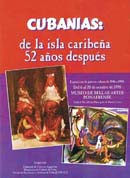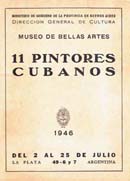Those who know about the history of Cuban art have probably found out that, in keeping with the historic rigor, this heading must be construed as a blunder because the group of Cuban painters and sculptors linked to abstraction and running by that name –due to the number of its members, eleven in all– never exhibited their works as a group in the South American nation. But the point is that number seems to have a special attraction among our fine artists, and if you’re in doubt about this, just remember that eleven artists huddled to launch that anthological exposition entitled Volume One, held in Jan. 1981 in Havana and that as the 1953 abstracts, they moved the airs of the Cuban arts, each and every one of them in his own fashion.
Then, what are those eleven we’re referring to in the heading of The Archivist’s fourth outing? Let’s begin by saying that the 1940s is a basic period of time in the development and international promotion of the Cuban art. At that time when the moving of exhibitions from one country to another was not a walk in the sun, especially when the planet was enduring World War II, a conflict that spanned through most of those ten years, Cuban painting put itself on the map with expositions in New York, Port-au-Prince, Guatemala City, Moscow, Mexico City, Stockholm and Santo Domingo. The first exhibition ever organized in South America took place in Argentina in 1946.
The history of this exhibit is quite curious and the boldface names there were Argentine painter Emilio Pettorutti and Cuban art critic Jose Gomez Sicre. The former was at the time director of the La Plata Museum of Fine Arts and some of his projects were meant to show the art of the Latin American countries. With that view in mind, he had deployed –in the purest Cuban style– an exhibit of Brazilian art and had already scheduled a few others for months and years to come. On the other hand, Jose Gomez Sicre –who had been a part of the anthological exposition in New York in 1944– took on the responsibility of handpicking artists and artworks from the turf for the exhibition.
Quite curiously, a couple of years after the exposition at MOMA, Gomez Sicre barely changed the list of artists and in his “Forewords” published in the catalog, he regretted his failure to bring in primitive painters Feliscindo I. Acevedo and Rafael Moreno just because canvases were not allowed for transportation reasons. Victor Manuel was not chosen, but the greatest absentee of all, as it had happened in previous occasions, was Wifredo Lam. Despite those conspicuous no-shows, we may say the entourage was pretty representative, carrying a grand total of 71 pieces from eleven artists: Amelia, Ponce, Carlos Enriquez, Carreño, Portocarrero, Felipe Orlando, Mariano, Diago, Girona, Cundo and Martinez Pedro.
Fortunately, the exhibition has not been thrown into oblivion –as it’s been the case of similar events, even some of the most outstanding ones. An excellent catalog picked up all the memories, including the personal photos of each and every artist together with biographical notes, images of their works and the list of them. Texts were written by Pettorutti and Gomez Sicre.
The second chapter of this history was starred by Cuban art critic Toni Piñera when, during a visit to Buenos Aires in 1998 –that is, 52 years after that grand opening of that exhibition– he “discovered” eleven artworks by Cuban artists at the La Plata Museum’s collection. With the help of institutions and Argentina-based Cuban artist Jorge Fernandez-Trebejos, he just unraveled the puzzle. It seems that Pettorutti, in addition to touting the Latin American art in his country, intended to turn that museum into a major cultural center for art collections hailing from the entire region. It was then when something almost magical came to pass; all of a sudden, those eleven pieces joined the artworks of a 35-artist exposition that Piñera was taking there and so many years later, several generations of Cuban artists were being on display under the same roof. The exhibit’s title was Cubanias: from the Caribbean island 52 years later.
According to Julio Girona, later on interviewed by the critic, the artworks had been purchased by the museum following the exposition and engrossed the institution’s own collection right after that.
As I’ve said before, an archive is not good enough to reveal all the secrets that wait to be figured out. For instance, whatever happened to the Pettorutti project? Perhaps an Argentine archivist might have the answer…


Related Publications

How Harumi Yamaguchi invented the modern woman in Japan
March 16, 2022
Giovanni Duarte and an orchestra capable of everything
August 26, 2020











